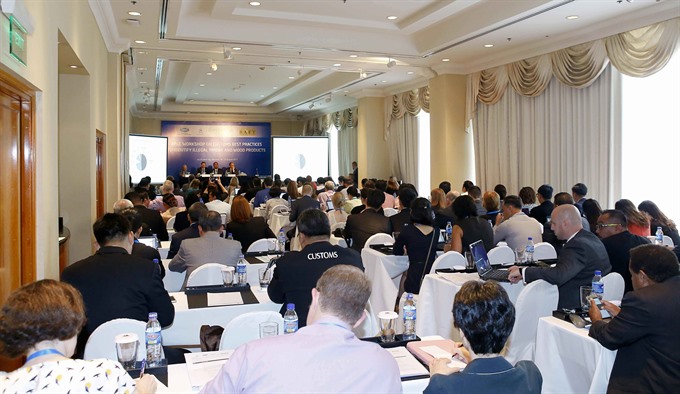 Society
Society

Eliminating illegal timber from supply chains and the global timber trade requires the use of best practices and tools that can precisely identify illegal products, experts said at a two-day workshop held during the third APEC Senior Officials Meeting (SOM-3), which began yesterday in HCM City.
 |
| Workshop participants at an APEC’s SOM 3 meeting discuss best practices to identify illegal timber and wood products. Source apect2017.vn |
HCM CITY —Eliminating illegal timber from supply chains and the global timber trade requires the use of best practices and tools that can precisely identify illegal products, experts said at a two-day workshop held during the third APEC Senior Officials Meeting (SOM-3), which began yesterday in HCM City.
Dr Nguyễn Văn Hà, deputy director general of Việt Nam Administration of Forestry under the Ministry of Agriculture and Rural Development, said that stronger anti-smuggling activities conducted by local customs departments would be the most effective measure to prevent the illegal timber trade.
He said that Vietnamese customs’ offices had improved their risk management systems by recording information on enterprises that violate regulations on the trade of timber.
“The General Department of Vietnam Customs has classified high-risk enterprises and individuals in both timber import and export,” he added.
It has also stepped up the exchange of specialised information and customs intelligence with international agencies for investigation, verification and analysis of hotspots for anti-smuggling of timber and wildlife.
Over the last decade, Việt Nam’s timber processing industry has made significant contributions to the national economy, gaining a strong position in the global timber and furniture market, he said.
“Timber and timber products are among the biggest exports of Việt Nam, with export turnover of US$7.2 billion in 2016, contributing to national economic growth, creating jobs, improving livelihoods and generating income for local people and communities,” Hà said.
Made-in-Việt Nam timber and wood products are available in more than 90 countries and territories, meeting strict standards and technical requirements of importing countries, especially for legal timber and timber products, he added.
The Voluntary Partnership Agreement on Forest Law Enforcement, Governance and Trade between Việt Nam and the EU, with negotiations concluded in May, shows that the Vietnamese government and enterprises are committed to fighting illegal logging and illegal timber use and trade, according to Hà.
As an economy that both imports and exports timber and timber products, the Government attaches great importance to prevention of illegal timber trade, Hà said.
Dr Đỗ Văn Bản, vice director of the Research Institute of the Forestry Industry, told Việt Nam News that the diversity of timber made it difficult to distinguish the different types of wood by sight.
He said that officials from customs and forest protection departments in the country would strengthen the application of IT to set up reference data and store photos of timber samples so that regulated and prohibited wood could be easily differentiated.
Though officials have received training on timber identification, he said they still needed to learn how to identify types of timber and wood more rapidly and precisely.
Speaking at the workshop, Jennifer Prescott, assistant US trade representative for environment and natural resources, said the trading of illegal wood products not only had a devastating effect on biodiversity but negatively affected the price of legal wood products and the legal, sustainable management of forests.
APEC Economies account for around 53 per cent of the world’s forests, 60 per cent of global production of timber products, and 80 per cent of global trade in timber products.
In 2016, the global export turnover of timber reached US$127 billion, increasing by 7.9 per cent compared to 2012, according to the International Trade Council.
The global export turnover of furniture reached $233 billion in 2016, an increase of 10.8 per cent against 2012; $131 billion in import turnover of timber; and $221 billion in import turnover of furniture in 2016.
However, illegal timber trade accounted for 10 to 30 per cent of global timber trade, with an annual value of $100 billion-$300 billion. —VNS